If you own a small business, you know the struggle: there’s never enough time.
You wear every hat, from sales manager to HR director to chief copywriter, and the relentless demands of running a business can feel endless.
For years, major technological shifts seemed to favor huge corporations with massive budgets and dedicated tech teams.
But that is finally changing. That crushing workload is starting to ease, thanks to one of the biggest technology shifts we’ve seen in decades: Artificial Intelligence (AI).
AI is rapidly becoming the most powerful, affordable, and flexible tool a small business can use. It works around the clock, handles complex tasks quickly, and is proving to be a true asset for entrepreneurs.
To understand how this shift is really happening on the ground, we performed a detailed AI adoption survey in October 2025.
We surveyed 400 local business owners and managers across the U.S. to see how they’re using AI, what their biggest benefits are, and what’s stopping them from using it even more.
The findings are remarkably clear. Small businesses aren't waiting for permission: they’re building AI into the very foundation of their operations. The goal is simple and pragmatic: to get more done, better and faster.
This isn't a future idea. It's an essential, daily reality for a growing number of American small businesses.
The New Normal of Daily AI Use
For a new technology to gain traction, it needs believers who are willing to try it out. AI has found them in the small business sector.
Our survey shows that business leaders are approaching AI with significant optimism, which is immediately translating into high, frequent use.
A Strong Vote of Confidence
When we asked business owners to describe their attitude toward AI, the results showed a strong vote of confidence.
A substantial 84% of those surveyed have a positive attitude toward AI tools. This wide acceptance is notable for a technology that only recently entered the mainstream.
This positive group is split into two telling categories: the enthusiasts and the measured users.
The most enthusiastic group, the early adopters, made up 45% and called themselves "enthusiastic early adopters." These are the innovators who saw the potential quickly and have already integrated AI deep into their workflows.
The other significant portion, 39%, are "cautiously optimistic." They are people who have seen enough proof to believe in AI’s power, but they are approaching it with a sensible eye on effectiveness and security.
Only a small fraction (3%) felt skeptical, and barely anyone was opposed.
AI as a Daily Habit
This positive feeling is backed up by how they work every day. AI is not a tool they pull out for a rare project; it’s a constant partner:
- 52% of respondents said they use AI tools daily for work.
- 35% use them a few times a week.
This means 87% of small business leaders are relying on AI as a regular, active part of their operation. They treat it as a fundamental part of their operational stack, much like their accounting software or customer management system.
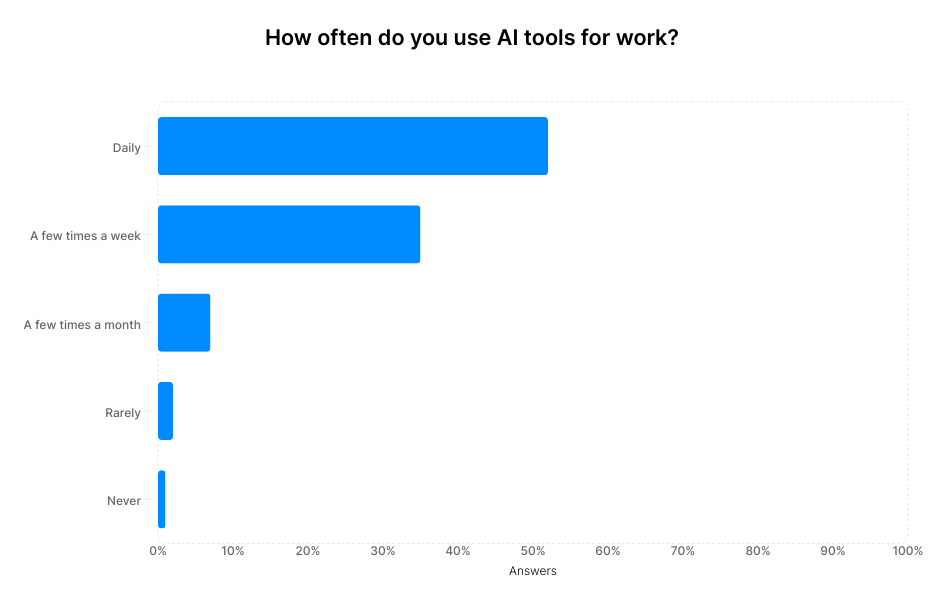
It’s also clear that business owners are customizing their tools to match their specific needs.
They aren’t sticking to a single AI solution, which suggests they understand that different models are better for different tasks. 59% of respondents said they regularly use 2–3 different AI tools or platforms.
This shows a strategic approach. They are mixing tools (e.g., a large language model for drafting, a specialized tool for image generation, and another for deep data analysis) to create a powerful, personalized tech setup.
This flexible approach is made possible by the wide accessibility of tools like ChatGPT (54% of users) and Google Gemini (27% of users), which act as central platforms for various tasks.
The choice of these general-purpose tools confirms that small business owners need versatility. They require tools that can handle a request for sales data in the morning and write a social media post in the afternoon, all from one place.
Hours Saved and Quality Gained
Why is this adoption happening so quickly? Because AI is delivering the single most valuable resource for a small business owner: time.
Our survey proves that for the majority of businesses, AI is saving real hours every week and improving the quality of their work while doing so.
The primary reason for adoption is purely practical: saving time and automating repetitive tasks (cited by 61% of respondents). This focus on efficiency has had an immediate and widespread effect on operations.
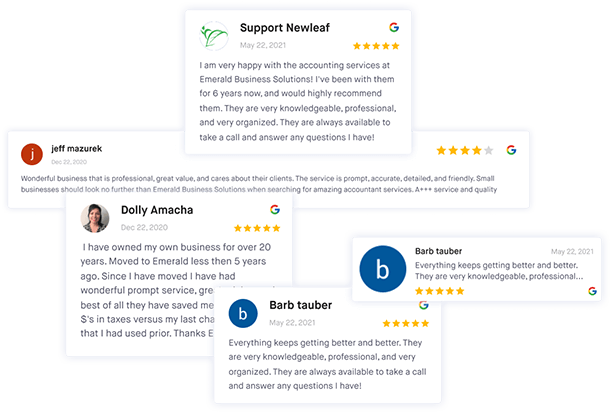
Manage online reviews with ease
Monitor, manage, and get more online reviews for your business with ReviewsOnMyWebsite.
The Productivity Boost
First, let's look at the overall effect on work. The results show that AI is a significant productivity booster:
A total of 85% of businesses reported that using AI led to either a significant improvement (39%) or moderate improvement (45%) in their productivity.
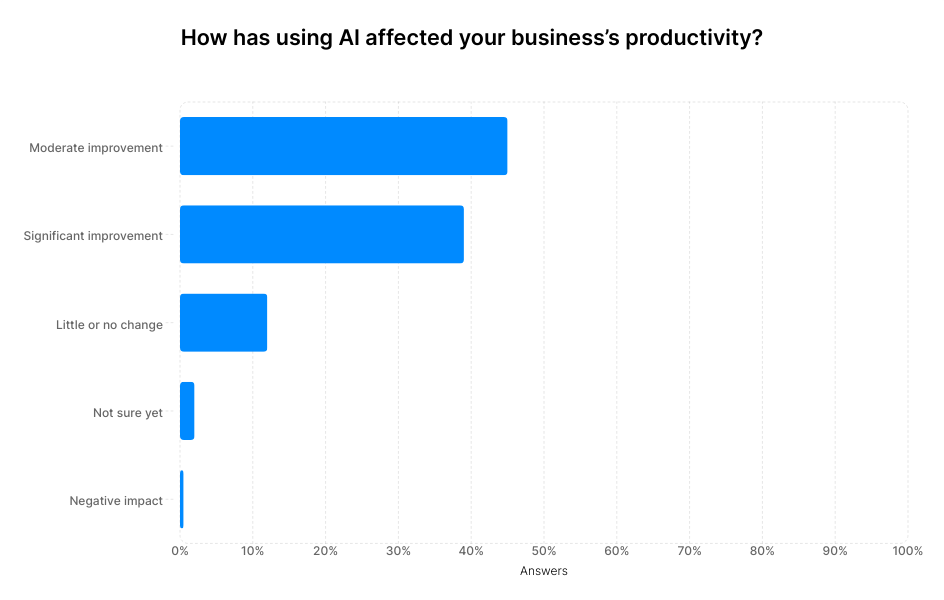
For a small team, where every person’s output counts, an improvement of this magnitude is a major advantage. It means the business can scale its output without necessarily scaling its headcount.
When asked about the biggest measurable outcome they’ve seen, the results clearly highlight the dual benefits of speed and quality:
- Saved time was the top answer at 45%.
- Coming in second, “improved quality of output” was noted by 31% of respondents.
This finding is very important. It indicates that small business owners are not sacrificing quality for speed.
Instead, they are finding that AI helps them draft, refine, check, and edit complex work, ensuring that the final outpu (whether it’s a technical report or a detailed customer email) is of a higher standard than what they might have produced manually in the same time frame.
They are operating both faster and better.
The Hours Saved
The time savings are substantial and are happening for almost everyone. This gain in capacity is nothing short of transformative for a resource-constrained small business:
- 96% of all respondents estimate that AI saves them or their team at least 1 hour per week.
- The single largest group, 37%, reports saving 3–5 hours every week.
- An additional 22% are saving more, banking 6–10 hours weekly.
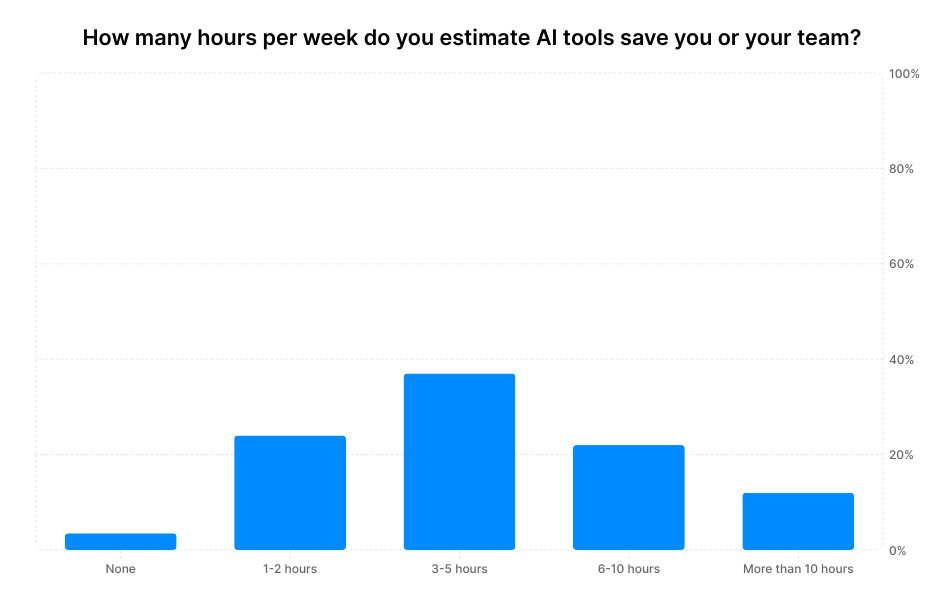
Saving three to five hours a week on a small team is a meaningful increase in capacity. This extra time is not just being used to finish work faster; it’s being redirected to higher-value activities.
Instead of spending hours writing documentation or manually pulling data, owners and managers can dedicate that time to things only humans can do: complex client negotiations, team training, or strategic community engagement.
This shift to strategic work is the true long-term value of AI adoption.
The Shift From Writing to Data Analysis
If you thought AI was just for writing social media captions, think again. Our survey shows that business owners are strategically putting AI to work in the most challenging and time-consuming parts of their operation: understanding and running their business.
While AI's ability to create content is important, its analytical power is what is driving its deep adoption.
When we asked about the main reasons for using AI, the answers revealed a clear movement toward deeper understanding. After saving time, the next two top reasons are all about thinking and strategy: analyzing data or reports (44%) and generating ideas or research (40%).
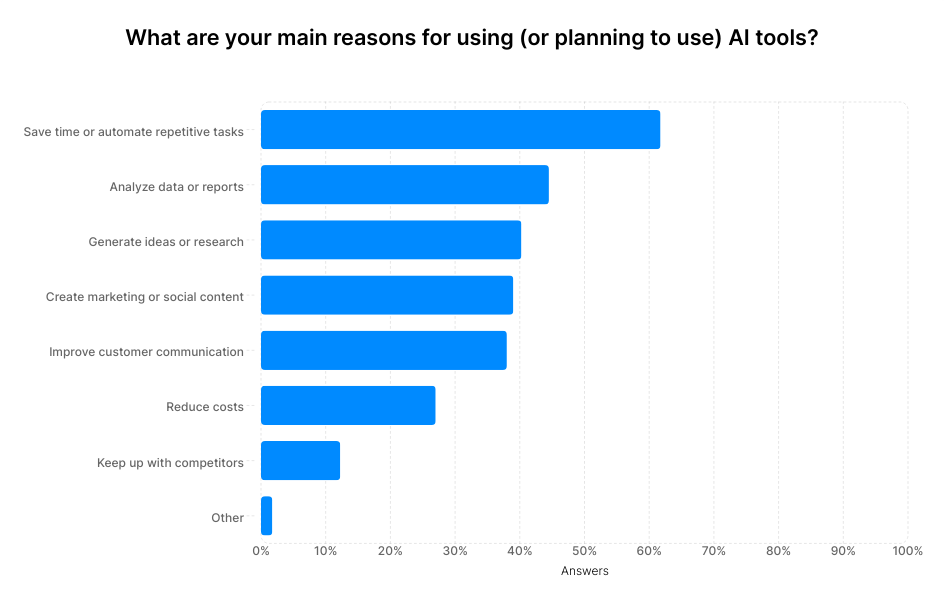
This proves that small business owners are using AI as an affordable analyst and brainstorm partner. For many, this is the first time they’ve been able to easily digest complex spreadsheets, market data, or operational reports without hiring a consultant or spending an entire weekend manually sorting through numbers.
This focus on analysis is clearly reflected in where AI is being used across the business. Usage is spread almost evenly across key departments, showing its versatility:
- Marketing and content creation (49%)
- Data analysis or reporting (49%)
- Administrative tasks (e.g., scheduling, documentation) (44%)
The fact that data analysis is just as common as marketing shows how crucial AI is for core operations. For a business that can't afford a full-time data scientist, AI is now filling that role, helping owners make smarter, data-driven decisions every day, essentially filling a major gap in small business operational intelligence.
The type of tasks they use AI for most often confirms this strategic focus:
- The number one task is analyzing data or generating reports (32%)
- Writing and editing text is second (22%).
This is a key takeaway: AI’s biggest value for small business is its brainpower. It is seen as a tool for making sense of information and driving better strategy, followed closely by its ability to generate content.
Balancing Trust: The Human Touch vs. The Robot
One of the most complex questions for any small business is how to balance efficiency with the personal, human touch their customers expect. We looked closely at where business owners draw the line with AI and customer interaction.
Trust in Customer Communication
The survey highlights a tension here. On one hand, a significant number of owners worry about "losing the human touch," a barrier cited by 27% of respondents. They know that their personal relationships with clients are often the foundation of their success.
On the other hand, they have pragmatic confidence in AI’s ability to handle routine communications. A majority of 71% either completely trust or mostly trust AI to communicate directly with customers (like replying to messages or emails).
This suggests a smart segmentation of tasks. AI is not expected to replace the owner during a complex client negotiation.
Instead, owners are using it for high-volume, repeatable messages (such as answering FAQs or drafting the first response to an inquiry), freeing up the human team to focus on the sensitive, complex, or personalized interactions that require genuine empathy and problem-solving.
This trust also extends to protecting the business’s reputation online, a key area for any local business. Owners rely on AI for two main tasks that save critical time and protect their brand: detecting fake or spam reviews (34%) and drafting review responses (33%).
They view AI as a valuable filter and a dependable writing assistant. They trust it to screen out bad actors and to provide a professional, on-brand starting point for a reply.
This hybrid approach allows them to respond quickly and professionally to almost every review without the owner having to start every reply from scratch.

Manage online reviews with ease
Monitor, manage, and get more online reviews for your business with ReviewsOnMyWebsite.
Roadblocks and Planning for Future Growth
While the benefits are clear, the path to full AI adoption isn't without its speed bumps. We asked business owners about the biggest challenges they face and what’s preventing them from using AI even more.
The Biggest Challenges
In their daily use of AI, owners run into these issues most often:
- Privacy or data security concerns (22%): This is the top worry. Owners are nervous about putting confidential company or customer data into public-facing AI tools. Since small businesses are often targets for data breaches, this concern is entirely justified and highlights a need for more secure, private-instance AI solutions.
- Lack of knowledge or training (19%): The tools change so quickly that it's tough to keep up. Owners and their small teams need simple, quick ways to learn the latest features without spending hours in dedicated training courses.
- Creating effective prompts (17%): Knowing how to speak to AI is a skill. Many people struggle with getting the high-quality results they need because they don't know the best way to word their requests.
Obstacles to Expanding Use
When we asked what is preventing more extensive use, the answers revealed barriers related to cost and time that stop them from fully scaling up their AI use:
- Cost of paid tools (28%): Subscription fees for premium AI features can add up quickly, especially when you’re using 2-3 tools. This is a significant budget item for a small business.
- Lack of time to learn new tools (27%): This is the ultimate catch-22. Business owners need AI to save time, but they don't have the time to sit down and master the tool first.
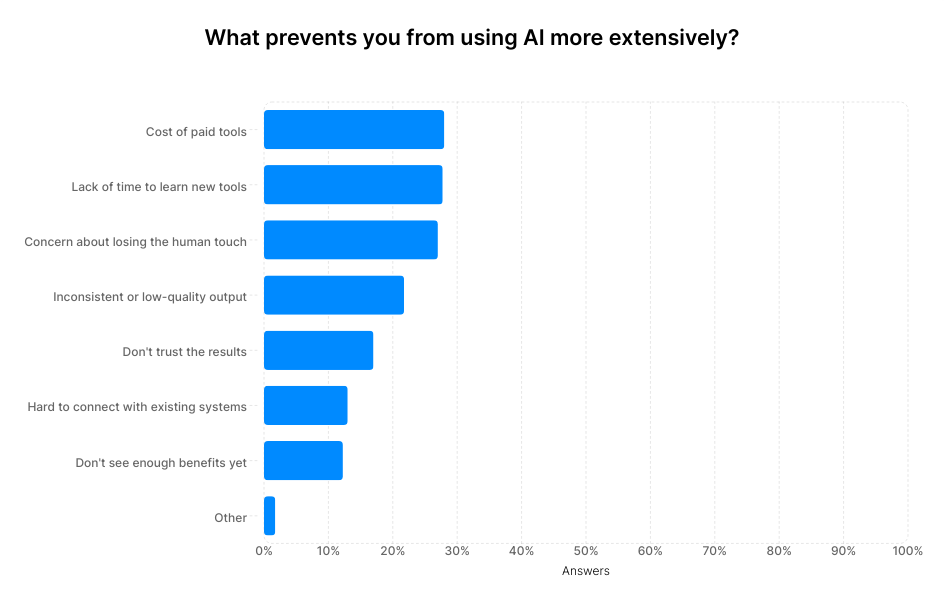
These two issues, combined with the worry of "losing the human touch" (27%), form the primary resistance to fully integrating AI. Overcoming these obstacles will define the next phase of small business AI adoption.
Planning for the Future
Despite these roadblocks, the plan for the future is overwhelmingly clear. The success owners are seeing now is fueling ambitious plans for the year ahead. The momentum for AI integration is only going to get stronger:
- A very large majority of 84% of respondents plan to expand their use of AI tools in the next 12 months.
- This group includes 40% who plan to expand significantly.
The small business owner has seen the proof: AI works. By giving them back hours, improving their output, and acting as a capable, 24/7 analyst, AI is earning its spot as the essential tool for the next decade of entrepreneurship.




